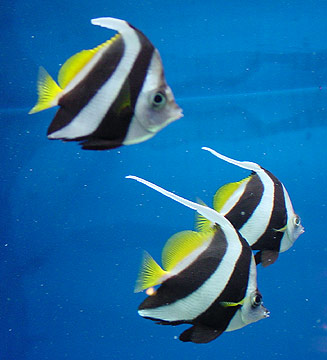Clown Barb

|
Scientific Name: Puntius everetti Price: Upon Request Origin: Southeast Asia, Malaysia, Indonesia Family: Cyprinidae NOT AVAILABLE NOW |
|
Other Names: Everett's Barb, Barbus Everetti |
|
Technical Info
Temperature: 25 - 28 ℃
pH: 6.5 - 7
GH: 8 - 12
Max size: 10 cm
Min Tank size: 80 Ltr
Position in Aqua: No special swimming level
Description
The Clown Barb has a torpedo shaped body and its tail is forked. It has only one dorsal fin. Lacking an adipose fin, a second dorsal fin to the rear of the first, is a characteristic of all the Cyprinid fishes. They sport a body color pattern that is true to their name, the Clown Barb. It is orangish brown on its upper body, orangish red on the sides, and has a yellow to whitish belly. Overall this combination gives it a reddish gold sheen. Then there are several (usually about four) dark spotted band type markings on the sides. It has red fins and sometimes a touch of red in the iris of the eye. All of these elements give this fish a rather 'clownish' appearance.
Food
Since they are omnivorous the Tiger Barb will generally eat all kinds of live, fresh, and flake foods. To keep a good balance give them a high quality flake food everyday. Feed brine shrimp (either live or frozen) or blood worms as a treat. This fish will eat as much as you feed them so the aquarist should determine a reasonable amount of food. The rule of thumb when offering food several times a day is to offer only what they can consume in 3 minutes or less at each feeding. When offering food just once a day, provide what they can eat in about 5 minutes.
Breeding
Clown barb can be bread in a large aquarium with shallow water. Make sure to cover the bottom with something like marbles to protect the eggs from the parents how will otherwise eat them. Remove the parents directly after the spawning. Move a pair of Clown barb into the breeding aquarium after they have been well conditioned on a varied diet. They produce up to 2000 eggs. These eggs hatch after 20-30 days and the young Clown barb can be feed powdered dry food. The fry are sensitive to poor water conditions.
Compatible with
This species makes an ideal addition to a peaceful community of riverine fishes such as similarly-sized Puntius, Rasbora, Devario, or Barilius species plus many botiid, nemacheilid and balitorid loaches.
Note
Adult males develop a more intense colour pattern than females and exhibit noticeable tubercules on the head when in spawning condition. Adult females tend to grow a little larger, are heavier-bodied, and less colourful.

